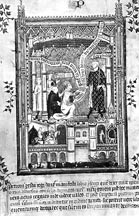

In 1317, King Philip V of France (The Tall) received from his chaplain Gilles, the abbot of Saint Denis, a luxury copy of a text entitled The Life of Saint Denis. The manuscript was begun during the reign of Philip IV (The Fair) at the command of Jean de Pontoise, Abbot of Saint Denis. The manuscript now preserved in the Bibliothèque nationale in Paris (French 2090-2092) contains seventy-seven miniatures illustrating the life and martyrdom of Saint Denis, the first Bishop of Paris and the patron saint of France.
For a number of reasons, this manuscript represents a fitting beginning to our course on Northern Renaissance art. The first part of our course will be devoted to an examination of fourteenth and early fifteenth manuscript illumination in Paris. During this period, Paris was the principal political, intellectual, artistic, and economic center in northern Europe. Paris was the capital of the French monarchy which had undergone a dramatic expansion of power during the twelfth and thirteenth centuries. The University of Paris with its theology faculty made Paris a major intellectual center.
The presence of the monarchy and university in Paris was an important stimulus for making Paris a major center of artistic activity, primarily book production. This was especially true from the middle of the fourteenth century under the Valois Dynasty notably Charles V (the Wise) and his brothers the Louis d'Anjou, Jean, duc de Berry, and Philippe le Hardi, the Duke of Burgundy. French royal and princely families assembled large libraries. These collections contained a range of religious books including versions of the Bible including French translations, theological texts such as St Augustine's City of God, liturgical texts such as Missals and Breviaries, and devotional texts, especially Books of Hours intended for private devotion. The aristocratic collections reflect an interest in ancient philosophy and history including French translations of the principal texts of Aristotle, the works of Roman historians including Livy and Valerius Maximus. Secular literature including romances and poetry were also well represented in these aristocratic collections.
These books were acquired in a number of ways. They could have been the result of a direct commission where the patron sponsored an author to produce a new text. Many books were also given by their authors to aristocratic patrons in hopes of some benefice. Manuscripts were also given as gifts. Books could also be acquired through the open market through direct commission or as a ready-made right off the shelf. In a culture that was highly tuned to seeing external display as a clear indication of status, these manuscripts were made as luxury productions including fine calligraphy, lavish border and text decoration, extensive pictorial cycles, and fine bindings. There was also strong competition between the different collections to keep up with or out do others in the quantity and quality of their manuscript holdings. This interest in book collection among the royal and princely families created a wider demand among the lesser nobility and wealthy bourgeois. Manuscripts were clearly status symbols that signified the owner's position within the social hierarchy.
This demand for books led to the development of a vital, secular book industry in Paris. In the shadow of Notre Dame cathedral along a street known as the "rue neuve de notre dame" and on the south or left bank of the Seine adjacent to the university lived and worked the different specialists involved in the book industry including scribes, decorators, miniaturists, book sellers. We will study the workings of this industry in much greater detail later in the course.
The Life of Saint Denis manuscript is an excellent example of this type of deluxe book made for royal patronage. The opening miniature shows Abbot Gilles presenting the book to Philip V:
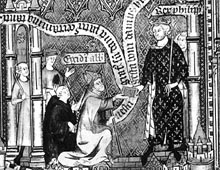
On the left standing in the doorway is
a chamberlain holding a staff controlling access to the King's
presence. Another court official with his left hand outstretched
introduces Gilles (Egidius), wearing the bishop's miter and carrying
a crozier, to King Philip. The scroll held by Gilles reads: "We
offer this written record of your good patron's deeds." A
monk, perhaps the author of the text, accompanies Gilles. Philip
is formally dressed wearing ermine lined robes decorated with
fleurs-de-lys and crown. 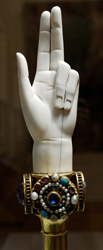 He holds in his left hand a staff known
as the Hand of Justice. The scepter on the left is a recreation of the Hand of Justice made for Napoleon at the beginning of the nineteenth century. He holds in his other hand a scroll replying
to Gilles's gift: " We are grateful to you for this account
of the ordeals of so great a father." The kneeling positions
of the abbot and monk and the use of hierarchic scaling assert
the authority of the king. Representing the formal relationship
between the donor and the recipient, presentation images are a
regular part of deluxe manuscript.
He holds in his left hand a staff known
as the Hand of Justice. The scepter on the left is a recreation of the Hand of Justice made for Napoleon at the beginning of the nineteenth century. He holds in his other hand a scroll replying
to Gilles's gift: " We are grateful to you for this account
of the ordeals of so great a father." The kneeling positions
of the abbot and monk and the use of hierarchic scaling assert
the authority of the king. Representing the formal relationship
between the donor and the recipient, presentation images are a
regular part of deluxe manuscript.
Another conventional scene in deluxe manuscripts is the commission image. These images represent the active role the patron played in the creation of the text. The authority of the text is thus signified in part by the authority of the patron. The Life of Saint Denis manuscript includes a miniature representing Saint Denis commissioning Saints Antonin and Saintin to write the story of his life.
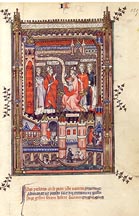
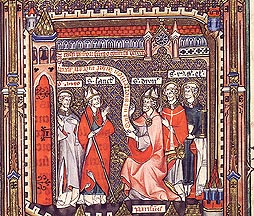
Hierarchic scaling, miter, central position, and X-shaped throne establish the authority of Saint Denis. His pointing gesture along with the banderoll he holds clearly establish him as the active speaker or authority while St Saintin's open palm gesture establishes his role as listener.
A companion volume (Paris, Bib. nat., lat. 13836) includes the signature of the scribe Guillaume l'Escot and dates its completion to 1317. Despite being commissioned by the Abbot of Saint Denis, the manuscript seems to have produced by the secular book trade and not in a monastic scriptorium.
Of particular interest in this manuscript is the series of thirty full-page miniatures including the presentation image that incorporate at their bottoms (bas-de-page) scenes illustrating the bridges of Paris:
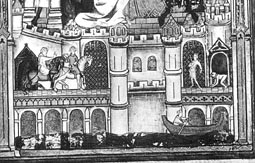
These bridges are certainly those that link the Ile de la Cité to the north (Right) and south (Left) banks:
see also Maps of Medieval Paris
The Ile de la Cité was the political and religious center of Paris. On its east end is located Notre Dame while the French royal palace including Sainte Chapelle, the royal chapel, is found at the west end of the island. The bridge connecting to the Right bank is the so-called Grand Pont while the Petit Pont links to the Left bank. These bridges also served as the residences and workshops of craftsmen and tradespeople. These small scenes present us an extraordinary representation of the economic and social life of medieval Paris. The commissioning miniature includes the following vignette:
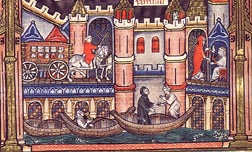
Here a group travellers arrive at the gate of the Cité. This reminds us of the important role the city walls played in the social, economic, and political life of the period. On the Petit Pont, a physician inspects a urine specimen while receiving payment from a woman. The river played a vital role in the economic life of Paris. Here a wine merchant has arrived with his cargo. Regulations prohibited the unloading of cargo by anyone other than a citizen of Paris. In order to bypass this regulation, the wine merchant sells a cask from his boat while another Parisian samples the wine in an adjoining boat.
At the bottom of folio 111 appears the following scene:
On the Grand Pont appears a money-changer and a goldsmith. There was not a national currency during this period so that the money-changer played an important role during this period. A watchman peers out from his tower guarding the gate to the Cité while a porter pushes his wheel-barrow loaded with bales. On the Petit Pont a beggar, carrying a small baby, receives alms from a woman cutler seated at the door of her shop with her wears prominently displayed on the wall behind. This detail reminds us of the important role women played in medieval economic life. Either as the support of a husband in the home based workshop or as an independent practitioner, women played a vital role in medieval industries, including book production.
Guillebert de Metz, description of Paris, 1434.